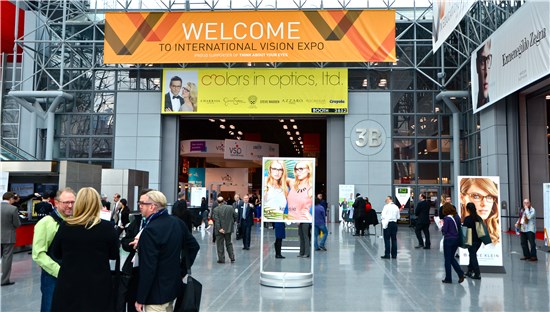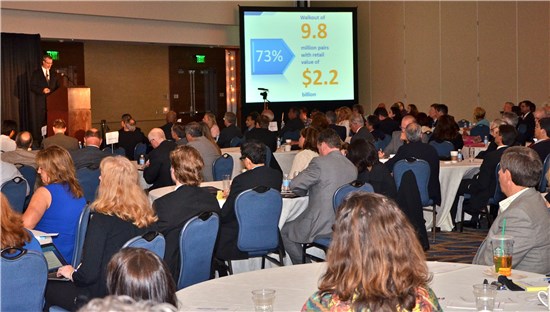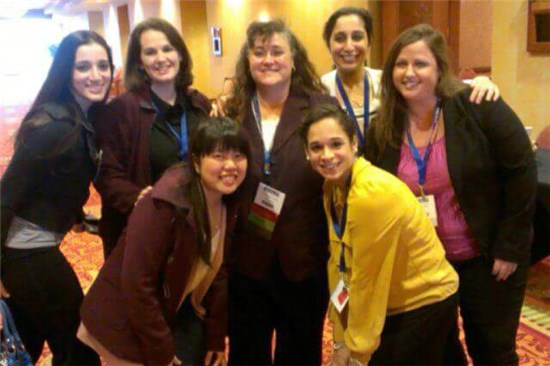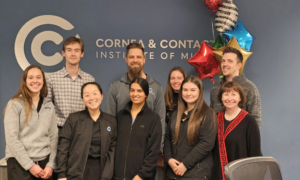By Suzanne LaKamp, OD, FAAO
March 30, 2016
SYNOPSIS
Attending meetings is costly and time-intensive—so make it pay off in clinical and business skills acquired. Available resources can help you pick the best CE courses and preview new technology–but leave time to network with peers, too.
ACTION POINTS
FOCUS ON BUILDING SKILLS. Plan well in advance to select courses and events that will build your skills, optimize networking, or enhance professional development.
PLAN FOR PAYOFF. Choose meetings that meet your goals for acquiring CE and business skills.
LEAVE EXTRA TIME. Don’t schedule classes and meetings back-to-back. Leave time for social events and for impromptu meetings with other ODs or business partners.
Attending professional meetings and optical trade shows means time out of the office, as well as travel expenses. To make it worthwhile for the exams you are not conducting (and the revenue you are not generating), consider the long-term benefits in terms of additional clinical skills and business knowledge that will pay off over time.
Choose Conferences that Pay Off
Any event which is likely to improve me as a clinician, optimize networking, or enhance professional development, is important to attend, regardless of how entertaining the event promises to be. If the event seems limited for clinical application, then I will not attend. In a previous practice, I fit many specialty contact lenses. It was relevant at the time for me to attend the Global Specialty Lens Symposium (GSLS). I also had scleral lens research to present with a colleague
I’m currently working in a specialized refractive surgery practice. GSLS, although a wonderful conference, is no longer highest on my list. I advocate for staying well-rounded as a practitioner, but it is more important for me at the moment to prioritize events or conferences directed to my specialty. It is more practical for me to stay current on new intraocular lenses than to attend lectures about the newest scleral lens on the market.
Dr. LaKamp, far left, with friends met at an optical conference, says that in addition to continuing education opportunities, conferences allow ODs to meet and network with peers.
Choose Conferences to Attend
For the last four years, I have attended the American Academy of Optometry (AAO), one of the most popular, national conferences for optometrists. It allows me the opportunity to catch up with former residency mates, and other colleagues who have moved around the country.
As a fellow of the Academy, attending AAO is the easiest way to accumulate the points necessary to maintain fellowship status. I have also attended the Heart of America Contact Lens Society (HOACLS) over the last few years, which is a regional conference in Kansas City, Kan.
As a resident of Kansas City, the convenience of HOACLS is unmatched. More recently, I have developed a fondness for the International Vision Expo Conferences, held on both the East and West coast. I learned about Vision Expo through former residency mates, and the benefits provided through the Young Professionals Club were an added draw.
The Young Professionals Club made attending Vision Expo affordable, providing up to six free credit hours to recent optometry graduates, and access to numerous networking or social events. ODs, opticians and industry professionals can join the Young Professionals Club (YPC), a group that promotes networking and social engagement. Requirements vary, but ODs who graduated within the previous five years may join the YPC. There are no membership fees, and many benefits are provided to members such as free Vision Expo exhibit registration and six hours of education.
It is important to stay connected with colleagues. Attending conferences is a great way to maintain those relationships, as well as to develop new ones. Going to Vision Expo, or a conference outside of my region, allows me to expand my professional network. I get to talk to people I would otherwise not have the privilege of meeting.

The entrance of International Vision Expo East 2015. Dr. LaKamp says that to maximize your educational opportunities, learn skills that will help you bring added value to your practice, making the missed time seeing patients worth it.
Project ROI of Taking Time Off for Conference
Even though I am an employee, I am dedicated to improving my performance and productivity as a professional, and, therefore, my value to the practice.
The business model is also unique to each situation. I cannot be absent from a refractive surgery practice on a surgery day during peak season, for instance. Not enough staffing means fewer surgical patients, and diminishing profits. For a day of routine post-operative exams, though, a well-planned absence might result in negligible loss to the clinic. Most post-operative exams do not generate revenue, and are included in the surgery fees. I just make sure not to miss a busy surgery day!
When attending conferences, I seek courses on refractive surgery, or try to speak with other doctors on that topic. I want to bring good ideas back to the clinic.
I rarely attend conferences with staff members from my practice. While I would greatly enjoy attending continuing education with co-workers, maintaining clinic coverage is essential to reduce potential revenue loss to a practice due to absence. It is nice, however, to attend conferences with former colleagues or classmates. I often sit through lectures with colleagues and friends. We then can discuss the lectures and presented materials in the hallways between classes. No one has time for lengthy discourse at the conference when trying to earn enough continuing education credit, get to meetings or catch a flight.
Some of the ideas I brought back to our practice include whether or not to implement post-refractive eye shields during winter and colder months, treating corneal abrasions or erosions with pain management similar to post-refractive PRK surgical protocol, and we discussed LASIK post-operative management for when flap slips occur. There are Optometrists in rural areas who reposition flaps. I do not agree with this. I work in a practice setting where, fortunately, there is always an available MD. We discuss scheduling with staff and fellow doctors to ensure proper coverage at all times, for the best interest of the patient.

Attendees at anoptometric conference learn about how to better manage their practice’s finances. Dr. LaKamp says that, along with clinical information, conferences can offer insight into how to better manage the business side of optometry.
Plan In Advance
My main concern in attending a conference is getting the appropriate education. Continuing education is necessary, not just to maintain licensing, but to stay current in new technologies and treatments. Planning is simple.
Before leaving for a conference, I will look at class schedules and speakers. I pick classes convenient to my travel schedule, courses relevant to refractive surgery, and try to maintain a breadth of education. I also favor classes with my favorite speakers. Material presentation is key for retention, which is why the speaker is the most important part of a lecture. Many conferences have apps now for smartphones, which is much simpler than carrying around grids of available courses and times.
Leave Time for Impromptu Meetings
Education and set appointments take priority at a conference. However, I try not to schedule too many classes or meetings back-to-back. By placing a few gaps throughout my schedule for the duration of a conference or event, I can accommodate serendipitous interactions with ease. I do not have a rigid schedule, and try to maintain flexibility, which also helps. I do not worry if I need to change one class for another with a better time slot. Flexibility may allow for potentially even more career growth, as opportunity can be hard to predict. Keeping the overall goals in mind, such as improving education and connecting with other professionals, makes attendance more enjoyable.
At the previous Vision Expo East conference, I met a colleague after a class lecture who also works in refractive surgery. I was curious about trends with displaced LASIK flaps. Winter weather creates post-surgical challenges, and I asked if other refractive surgery practices noted the same trend. From the conversation, I learned about some various eye shields that could protect the eye from wind and cold exposure after refractive surgery. I was able to discuss these options at a later time with one of the surgeons where I practice. Practices always look for methods to improve patient care results.
USE ONLINE RESOURCES TO PLAN YOUR CONFERENCE
Many large shows, like Vision Expo, provide an overview of upcoming meetings, as well as previews of new and popular courses to help you select CE.
The AOA Optometry’s Meeting site provides conference highlights to plan your travel schedule, along with FAQs to help you key in on specific logistics or e-mails for people who can answer your questions.
You also can preview exhibitors and decide from brief descriptions if you want to check out new instruments or products
SECO, in particular, provides easy-to-read course descriptions that help you to see exactly what you’ll gain from a course, as well as networking opportunities like alumni receptions. —ROB Editors
Keep Up with Upcoming Conferences on Social Media
Social media is the best way to advertise for events. Facebook, for instance, is one of the most popular tools available. I recommend checking Facebook event pages for the most updated information.Facebook pages get the information out to a broad audience, are accessible, and easily shared. Whether you like Facebook or not, it is undeniably a resource you should check for opportunity. Facebook pages can update venue information more quickly than standard event web sites. More people can connect via social media, than through using e-mail.
Social media also is a great resource for reaching a large audience, and less likely to be ignored than e-mail. Sorting through e-mail is typically a chore, whereas social media is fun and where people turn to unwind.
However, I never use social media to set up important appointments. If someone wants to reach me for personal or professional reasons, it is better by cell phone or e-mail.
Stay in Touch with ODs You Meet
Connecting with other doctors helps us improve as clinicians and as a profession. The exchange of clinical experience is important, for instance, to help us better care for our patients. Working as a cohesive group, for the betterment of the profession, ensures that our privileges in patient care are maintained, and in some instances, expanded. Good relationships with vendors are also important to help grow practices. To stay in touch is simple. Exchanging business cards is always good practice.
I also might send a follow up e-mail, hand-written card, or connect through a service such as LinkedIn. Reaching out is dependent on which avenues are more appropriate to the particular situation. I once mistakenly took another doctor’s luggage while at the AAO conference a few months ago, after sharing a cab from the airport! I returned the luggage, of course, but was able to later reconnect with, and buy the doctor’s meal while waiting for flights at the conclusion of the conference. We both work in refractive surgery, so it was a neat contact to make.
Implement New Ideas When Back In Office
I share interesting, or important, ideas from conferences with staff and fellow doctors. Most of the doctors can relate ideas to each other casually during the day. I share a large office with the surgery staff, and the doctors at my practice. There are few barriers to communication when you spend a good portion of the work day in close quarters. E-mail is another great way to send information, typically regarding any new clinical pearls, or brief points. Ideas that warrant more thought and discussion, such as clinical or surgical protocol changes, are discussed at monthly doctor meetings.
Discussing the new information soon after the conference keeps the ideas fresh. Repetition and dialogue help retention. Getting other viewpoints is critical, as not all new ideas are potentially beneficial to a practice. There is no sense in changing something about the practice if it does not yield better results, whether that is improved patient satisfaction or revenue.
For example, bringing LipiFlow into a primary care optometry clinic because it is increasing in popularity is the wrong idea. There needs to be a large enough population of patients who can support the cost of the technology. Bringing in LipiFlow to treat a clinic geared for dry eye patients helps those suffering patients, as well as practice revenue. When you have a population of patients needing a certain technology, then that is the right time to make an investment in a product in-house. The decision point should not just be popularity.
Conferences are a great way of learning about new or improving technologies. Tools in diagnosis, or treatment, in patient care are constantly evolving. Conferences are great for staying current with the rapid changes in technology.
Suzanne LaKamp, OD, FAAO, is an associate at Durrie Vision in Overland Park, Kan. To contact: dr.suzanne.lakamp@gmail.com




























